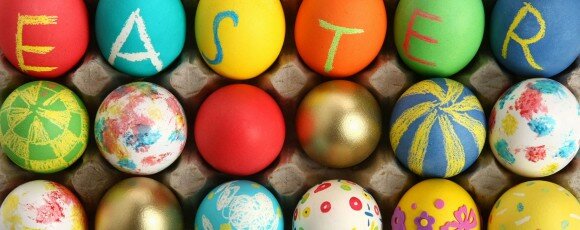
EASY (Levels A2/B1)
When we think of Easter, we think of painted eggs, the Easter bunny, and chocolate. But what are the origins of Easter?
The festival of Easter is a Christian adaptation of a pagan ritual. Pagans believed that eggs represented fertility and rebirth and the Christian Church also made the eggs a symbol of religion. At Easter they painted eggs, and gave these as presents – a ritual that still exists today.
The Easter Bunny, like Santa Claus at Christmas, is a mythical creature who gives presents to children at Easter. The hare, like the egg, has been a symbol of fertility for a long time. The long-existing idea that the hare can reproduce without losing its virginity, made people associate the hare with the Virgin Mary.
The progression from real hand-painted eggs to chocolate eggs came from the Germans. In the late 1800s, they filled baskets with hare-shaped pastries and chocolates. This developed into the production of solid chocolate eggs which people began to give as presents with the more traditional egg. In World War II cocoa was rationed, and American confectioners decided to make hollow Easter eggs to maximise production. These holl0w eggs are still produced today, and are more common that the solid eggs.
On Easter morning children look for these eggs, which the Easter Bunny (with the help of adults) leaves for them, often in hidden places. Often non-Christians celebrate Easter too because these fun activities and the invention of the chocolate egg and Easter Bunny have commercialised the festival to a certain extent.
![Chocolate-Easter-Egg-easter-eggs-30423588-2200-2198[1]](/blog/wp-content/uploads/2013/03/Chocolate-Easter-Egg-easter-eggs-30423588-2200-219811-300x300.jpg)
DIFFICULT (Levels B2 + )
Easter – we all know that it represents the resurrection of Christ according to Christianity, but how many of us actually know that many of our Easter traditions (looking for painted eggs that the Easter bunny has left for us, or consuming massive quantities of chocolate treats) have more to do with early Pagan beliefs than Christianity?
Well, the festival of Easter is in fact a classic example of the early Christian church adapting an existing pagan ritual to suit their own purposes. Pagans believed that eggs represented fertility and re-birth and consequently, the early Christian Church decided to stain eggs in red dye representing the blood of Christ. This then led to the egg becoming an official symbol of Christianity. As a result of the Church’s appropriation of the egg as a symbol of religion, it became common practice to give hand painted eggs as presents at Easter time.
So, the origins of the painted Easter egg are easy to understand, but when did the tradition of giving chocolate eggs start? And where does the Easter bunny come into all this?
Nowadays the Easter rabbit or bunny is analogous with Santa Claus or Father Christmas, in that it is a mythical creature that gives gifts to children on the eve of their respective holidays. However, the inclusion of the rabbit or hare as a symbol of Easter is somewhat circumstantial. The hare, along with the egg, has long been seen as a symbol of fertility, and there has long existed the idea that the hare can reproduce without losing its virginity, thus easily lending itself to a comparison with the Virgin Mary.
The progression from real hand painted eggs to eggs made out of chocolate is due to the Germans. In the late 1800s they began to fill baskets with hare shaped pastries and chocolates. This then developed into the production of solid chocolate eggs which began to be exchanged along with the more traditional egg. However, it would not be until World War II that the hollow egg came into existence. Due to the rationing of cocoa, American confectioners decided to make hollow Easter eggs to maximise production.
These eggs are often hidden for children to find on Easter morning, which may be left by the Easter Bunny. They may also be put in a basket filled with real or artificial straw to resemble a bird´s nest.![easter_bunny[1]](/blog/wp-content/uploads/2013/03/easter_bunny11-276x300.jpg)
It can be seen that the invention of the chocolate egg and bunny has gone someway into making Easter the commercial celebration it is today. Nowadays, like many other typically Christian celebrations, such as Christmas, Easter is celebrated to a certain extent even by non-Christians, who participate in the commercial aspects of the festivity, even though they eschew the religious principles behind it.
Now we know what happens at Easter time and we understand the beginnings of the egg as the ultimate symbol of this celebration, there only remains on important question to answer: when exactly is Easter?
One strange aspect of Easter, which is unique to Christian festivals, is the fact that it does not have a fixed date according to the civil calendar. This means that although it always falls on a Sunday, as this is when Jesus resurrected, the date is different every year. It is in fact the first Sunday after the first full moon following the March equinox that decides the date of Easter.
Happy Easter!



